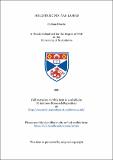Files in this item
Holosteric Nd : YAG lasers
Item metadata
| dc.contributor.advisor | Sibbett, Wilson | |
| dc.contributor.author | Norrie, Callum | |
| dc.coverage.spatial | 196 p. 7 p. of plates. | en_US |
| dc.date.accessioned | 2018-06-06T10:00:23Z | |
| dc.date.available | 2018-06-06T10:00:23Z | |
| dc.date.issued | 1991-07 | |
| dc.identifier.uri | https://hdl.handle.net/10023/13755 | |
| dc.description.abstract | A miniature Nd:YAG laser that was transversely pumped by a quasi-cw laser-diode array has been designed and constructed. This laser was injection seeded by a continuous wave single-frequency Nd:YAG laser that was also pumped by a laser- diode array. This was the first reported holosteric, or all-solid-state, laser that was capable of generating single frequency pulses in a high quality single transverse mode beam which it achieved at peak powers up to 7 kW. Two different types of laser-diode array were used in this work, and both have been characterised with respect to their use as pump sources for solid-state lasers. A fibre-coupled type SDL-2430-H2 laser-diode array, which emitted 100 mW from the end of a 100 mum core diameter fibre at the Nd:YAG absorption wavelength of 809 nm, was used to longitudinally pump a continuous wave Nd:YAG laser. Spatial hole-burning encouraged this laser to operate on several longitudinal modes, with an output power of up to 31 mW. With the addition of an etalon and a Brewster angled plate to the cavity of this laser, single longiuidinal mode operation was achieved at an output power level of 10 mW. The frequency from this laser was stabilised against thermal drift by phase sensitive locking to the resonance of an external reference cavity. The pump source for the transversely pumped Nd:YAG laser was an SDL-922-J quasi-cw laser-diode bar, which emitted from its 1 cm wide aperture pulses of 200 mus duration with energies up to 5 mJ at reperition rates between 10 - 100 pps. The characteristics of this laser-bar that were measured include a frequency chirp of 5 nm through the pulse, which was found to have a significant effect on the pumping of the Nd:YAG medium. An analysis of the pump-rate distribution throughout the Nd:YAG laser-rod was undertaken with reference to the transverse mode structure of this laser. This was used as the basis of a full rate-equation-based model of the transversely pumped laser. Fundamental transverse mode pulses with energies of 1.1 mJ were generated when the aperture provided by the Nd:YAG rod itself was used to suppress higher order modes. Upon Q-switching the transversely pumped laser using an acousto-optic modulator, single transverse mode pulses with peak power of up to 13 kW were produced. This laser was induced to operate on a single longitudinal mode by injection seeding with the single frequency diode-pumped laser. Operating at a peak power of 7 kW, this holosteric laser was particularly "well-behaved" with a pulse-to-pulse intensity stability of 6% over 100 pulses. A LiNbO3 electro-optic Q-switch configuration was implemented as optical damage to the acousto-optic component had limited the intracavity flux intensity. Development of these lasers towards higher peak power microlaser systems for applications including range-finding and surgery is continuing. | en_US |
| dc.language.iso | en | en_US |
| dc.publisher | University of St Andrews | |
| dc.subject.lcc | TK7871.3H7N7 | |
| dc.subject.lcsh | Lasers | |
| dc.title | Holosteric Nd : YAG lasers | en_US |
| dc.type | Thesis | en_US |
| dc.type.qualificationlevel | Doctoral | en_US |
| dc.type.qualificationname | PhD Doctor of Philosophy | en_US |
| dc.publisher.institution | The University of St Andrews | en_US |
This item appears in the following Collection(s)
Items in the St Andrews Research Repository are protected by copyright, with all rights reserved, unless otherwise indicated.

